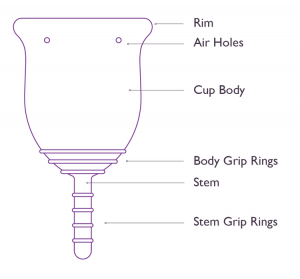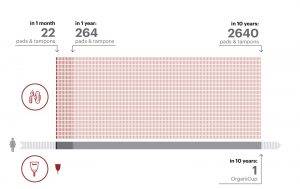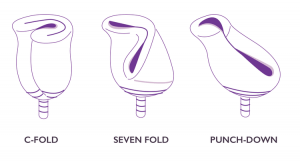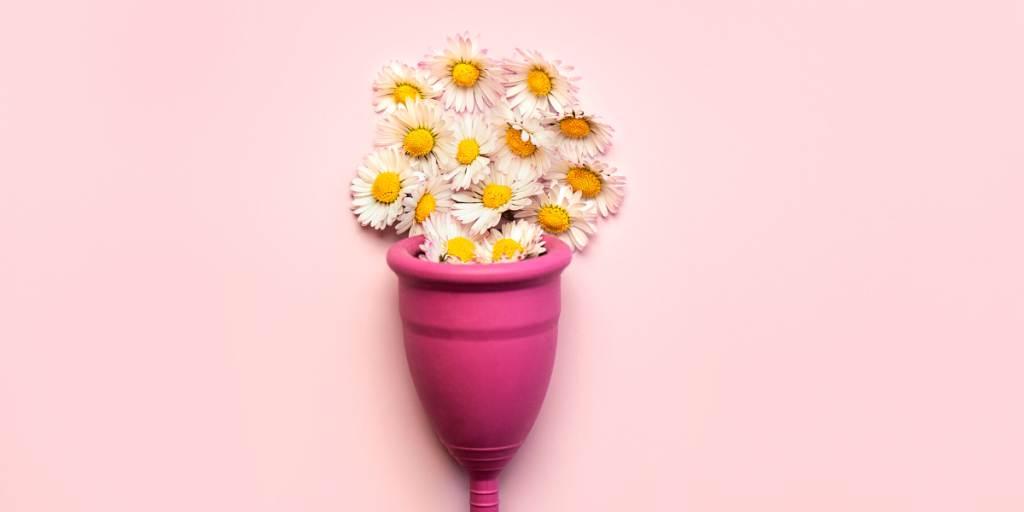Do you feel comfortable discussing menstruation, menstrual cups, tampons and all things period related? In many places menstruation has just started to be a more acceptable topic to talk about. It has historically been surrounded by all sorts of taboos and myths and unfortunately still is in a lot of places. However, over the years scientific knowledge and democratisation of the subject has allowed more open discussion on how to make periods more comfortable for women. There is still a long way to go to make this natural event a comfortable topic for all though!
It’s Environmenstrual Week currently and one of the big aims of this week is to encourage conversation around periods and continuing to break down the taboos. It’s also all about raising awareness that conventional single use period products contain plastic and other harmful chemicals.
Plastic period
Over time pads and tampons have become the standard, go to period items. However, like all single use items, disposable pads and tampons have generated big waste issues. Overall, tampons, pads, panty liners and their packaging generate more than 200,000 tons of waste per year. All these items contain plastic – in fact, pads are around 90% plastic! As we know from all the work we’re doing here at the Ocean Mimic, plastic waste mostly ends up in a landfill or, even worse in the oceans and rivers. Unfortunately 1 in 100 pieces of plastic in the ocean is a period product!
There are viable alternatives to single use period products and it is great to see the availability and popularity of these more eco-friendly period products increasing. There are a wide range of options from reusable pads and period underwear to reusable tampon applicators and menstrual cups. Although every option presents advantages, we’re going to focus on the benefits of menstrual cups and how to use them safely in this blog …

A boom of menstrual cups
Menstrual cups no longer need much introduction. These little flexible cups made of latex rubber or silicone have made their way up in the feminine hygiene global market. Reaching more than 20% of market share in 2018. Thus quickly catching up with tampons (around 25%) and pads (around 40%). It is estimated that menstrual cups are going to keep growing by approximately 7% per year between 2018 and 2026. This is a bright future for this eco-friendly alternative to disposable options.
The main reason for this rise in popularity comes, indeed, from the product’s environmental impact. Organicup published the below clear visualisation, showing that just 1 woman using 1 menstrual cup replaces up to 2640 tampons and pads over 10 years.

Although menstrual cups are increasingly popular, a lot of women are still being cautious about trying them. If you are using menstrual cups, chances are you have already heard questions like “How do you insert it?”, “Is it not going to leak?”, “does it hurt” or “Is it safe?”? Here is your chance to share this guide with your friends, so they can make up their mind! Or if you are thinking of making the switch to menstrual cups, yourself, you made it to the right place.
Let’s boil down some of the major answers to common worries about menstrual cups into simple and comprehensive explanations.
How do you insert and clean a menstrual cup?
There are different ways to insert a menstrual cup inside your vagina. The most important rule to remember is this: You must feel comfortable! There is an appropriate solution to each person and morphology. The only compulsory rule is to keep your hand as well as the cup clean. The same way you would not insert an unclean tampon in your intimate parts and would wash your hands before and after doing so, same applies to inserting a menstrual cup. Overall, these are the main steps you can follow, and adapt according to your preferences:
Hygiene
It should be noted that a cup must be sterilised before its first use. Do this by plunging it in boiling water (100°C) for about five minutes. This process should be repeated between every cycle, in order to guarantee that the cup is sanitized. However, between two uses during the same cycle, washing the cup and your hands with warm water and soap to avoid introducing bacteria in your vagina is enough, provided you wash them for about 2 minutes before rinsing.
Position
After washing your hands and the cup properly, find a position you are most comfortable in. Some women choose to squat, some stand and put one leg up, while some prefer to have their knees apart when sitting on the toilet. Again, there is no better technique when it comes to pick what position you prefer. Only get to know yourself and what your personal preferences are.
Fold your cup
Once you are in the perfect position for you, it is time to find the most adapted way for you to fold your cup. Here again you have various folding techniques you can choose from. You should experiment all of them and see what works for you. Although the C-Fold technique is the most commonly used, it might not be the one for you. Only practice will tell!
Relax
You will then need to keep the cup folded the way you decided until it is fully inside your vagina. It is essential for you to be relaxed in order to facilitate the insertion process. You will not feel any pain, especially if you are already used to inserting tampons. If you still feel nervous after reading these recommendations, do not forget you can always use some water as a lubricant to make it easier.
Check placement
Once the cup is inside your vagina, you can remove your fingers to let it pop open. You can put your fingers in and feel around the base of the cup. If you feel some folds, the cup has not open properly. It should feel round and rest against the walls of your vagina. This forms a seal to prevent leakage. The blood then simply drips into the cup.

Is the cup going to leak?
It is hard to simply say women will never encounter any leak with menstrual cups. It is more accurate to say that the more accustomed you will get to the cup, the lower the risk of leakage.
If your cup is well inserted, the cup must have folded out completely, while forming a suction seal which prevents leaks, and allows the blood to accumulate in the cup.
On average, a woman bleeds the amount of a teaspoon per day (5ml) on her period. Of course, some women can have a more important flow. However even double of this amount would still fit a small cup model. In addition, different sizes are available according to both your flow and the shape of your vagina. A bigger size is recommended for women who have given birth.
A major point that needs to be repeated about menstrual cup is that perseverance is key. Although it requires a bit more effort and investment in the first place, it is more rewarding than the disposable alternative. So don’t give up! Solutions exist to prevent potential leakage from being a problem. Remember you can always replace disposable pads with reusable cloth menstrual pads or period-proof underwear for maximum protection. Especially while you are still getting used to inserting your cup properly.
How do you remove it without being too messy?
This is a legit concern. After all, instead of absorbing women’s flow like tampons do, a cup collects it until you take it out of your vagina and empty it. This process might put some women off. However, this is not as scary as it may sound, and it only takes practice and to follow a few tips to avoid making it messy. Getting a bit of blood on the tip of your fingers is the worst you can expect, provided you do things right. Not much to pay to save our planet!
The first step to follow is to find the most comfortable position for you to relax before you even try to remove it. Getting nervous and have your body tense will only make the muscles of your vagina contract and will make it harder for the cup to slip out. You will then need to release the seal without forcing the cup out by pulling the stem. Not only, forcing the cup out would be a bit painful, but it would also increase the risk of the cup spilling out. You can use your index and thumb to squeeze the cup where the base meets the stem to release the seal.
Once the cup is ready to be removed, you can slowly slide it out and empty the cup in the toilets. You only have left to clean the cup perfectly with soap and warm water before reusing it.
This process will not only allow to keep things as clean as possible, but it will also help you getting to know your body and flow.
Can you keep being active with a cup?
Cups are most definitely the best option to keep active during your period. The string coming out of tampons can sometimes cause chafing while menstrual cups do not present that issue. If used properly, there is typically no leakage from menstrual cups, even for heavy workouts. The only activities that could require to be more cautious are those involving a lot of stretching movements, such as yoga. Even so, leakage would be unlikely if you use the adapted size for your cup.
What about water sports? Women often worry that diving or swimming during their period might not be safe. It is a common belief that blood leaking into water will attract sharks. Let us reassure you. In reality, sharks cannot smell blood from miles away. In addition, the amount of blood lost per day is very small, few millimetres only. If this was not enough, blood will stop flowing underwater because of the increase in pressure. Therefore, no risk to be eaten alive!
On a more practical note, menstrual cups present additional advantages. The absence of a string attached to menstrual cups will make the protection more invisible. No string sneaking out of your bikini bottoms or your mimic suit! Menstrual cups offer competitive advantages in terms of hygiene, as they can be washed and reused. They also don’t contain harmful chemicals like tampons can. This is overall safer, especially when having to keep your internal protection a bit longer due to logistics difficulties (being on a boat is not always the easiest context to change your menstrual protection regularly!).
These considerations lead us to a crucial question about the use of menstrual cups.
Are menstrual cups safe?
Using internal protections is definitely a game changer as it allows women to simply keep on with their life without too much hassle. However, this comfort comes with a price. Researchers are not sure yet whether menstrual cups are better than tampons at preventing the risk of Toxic Shock Syndrome (TSS). TSS is a rare (risk of about 1 in 100,000) and acute, potentially lethal infectious disease caused by a bacterial toxin that enters the bloodstream.
Hygiene as well as changing your protection regularly are necessary to limit the risk. Christine Greves MD, an ob-gyn with Orlando Health System in Florida, says that it is best to empty a menstrual cup every four to six hours, like with a tampon. It will of course depend on every woman’s flow. Some women might have to clean their cup more often.
Sellers often use the possible extensive use of menstrual cups and how they are leak-proof for up to 12 hours as a marketing point. However, it is easy to see how harmful this type of misinformation could be. Let’s face it, 4 to 6 hours is a fair amount of time without having to worry about cleaning your protection. All women should stay safe and lower the risk to zero by following these precautionary measures.
How expensive are menstrual cups?
Convinced already? Great news is, there is no bad surprise with the price! A quick calculation gives a rough idea of how much you could save over time, using a menstrual cup. If we only take the US as an example and assume that the average menstrual cycle uses 12 tampons and 4 to 5 pads, that equals to about $50 per year. By switching to a $25 menstrual cup, you could save $475 over ten years and $1,187.50 over 25 years. Of course, the range of prices goes from lower to higher than $25, so this is just an average.
No more excuse to not give it a try!
Check out #periodswithoutplastic, #endperiodplastic and #environmenstrualweek for even more info.
Sources:
Feminine hygiene market growth, trends and forecasts


